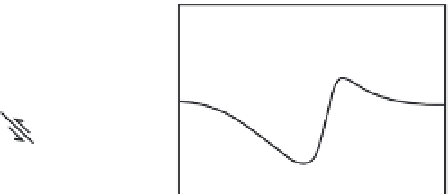Geology Reference
In-Depth Information
A
Interseismic
Deformation
Coseismic
Deformation
Geologic
Structure
500
500
inferred
measured
measured
eroded
250
250
mass
footwall
basin
0
0
-250
-250
-500
-500
-30
-15
0
15
30
-30
-15
0
15
30
-30
-15
0
15
30
Flexure
Due to Load
B
Interseismic
Deformation
Postseismic
Relaxation
500
500
250
250
sediments
0
0
-250
-250
viscous
flow
-500
-500
-30
-15
0
15
30
-30
-15
0
15
30
-30
-15
0
15
30
Distance (km)
Fig. 4.30
Conceptual model of deformation in thrust-faulting regimes that produce observed geological
structures.
A. The mismatch between the observed coseismic deformation and the geological structure (which integrates over
many earthquake cycles) defines the pattern of interseismic deformation. B. The interseismic deformation is
interpreted to result from viscous flow in the mantle and isostatic responses to sediment loading and erosion.
Note carefully the horizontal offsets in the deflections from one panel to the next because these indicate how the
distribution of deformation varies for each contributing variable. Modified after Stein
et al.
(1988).
the hanging wall, which is sitting above the
thrust fault, would experience subsidence, as
well as coseismic uplift. Two factors contribute
to this pattern. First, thrusting of the hanging
wall causes a redistribution of regional loads on
the crust. Given an elastic crust with some spe-
cific wavelength of flexure, such a thrust load
should produce a sinusoidal flexure that is
dampened with increasing distance from the load
(Turcotte and Schubert, 1982). Second, during
the interseismic phase, part of the subduction
interface is locked. As a consequence, part of
the overlying crust bulges upward or downward
as crustal plates on either side of the locked
zone move inexorably toward each other. Much
of this elastic strain is recovered by coseismic
uplift or subsidence during the subsequent
earthquake. In most earthquakes, the more
distal, damped flexure is geomorphically
undetected, but in a large earthquake (as in
Alaska), where an extensive, crenulated shore-
line can serve as a marker of uplift, the variable
flexure leaves a clear signature. Whereas the
largest earthquakes appear to be limited to sub-
duction zones, numerous destructive
M
=
8 thrust
earthquakes occur due to continent-to-continent
collisions and within intracontinental deforma-
tion belts. Along with many smaller temblors,
these earthquakes underpin the growth of
topography in ranges like the Himalaya and
Tien Shan and help produce the landscapes that
tectonic geomorphologists like to study.
Despite the initial coseismic asymmetry
during thrusting, which results in accentuated
hanging-wall uplift compared to the footwall
(Fig. 4.28A), erosion of this uplifted hanging
wall, deposition in the depressed footwall, and
isostatic adjustments to these changing loads
and to the coseismic load lead to a geological
structure in which subsidence of the footwall


















































































































































































